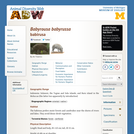
Babyrousa babyrussa: Information
- Subject:
- Life Science
- Zoology
- Material Type:
- Reading
- Provider:
- University of Michigan Museum of Zoology
- Provider Set:
- Animal Diversity Web
- Author:
- Ati Tislerics (author), University of Michigan
- Date Added:
- 02/17/2000

Babyrousa babyrussa: Information

O Atlas Bacia Hidrográfica do Paraguaçu sob diferentes perspectivas, constitui um dos Produtos Técnicos Educacionais da dissertação intitulada “Percepções e mapeamento de conflitos socioambientais relativos à água nos limites da bacia hidrográfica do Paraguaçu”. O atlas tem como objetivo apresentar a Bacia Hidrográfica do Paraguaçu (BHP) a partir de proxies de conflitos socioambientais registrados em seu território, por meio de uma perspectiva multidisciplinar e interdisciplinar, sob diferentes aspectos.

The conflict in Colombia has established itself as the longest and one of the most complex armed conflicts in the world. Since colonial times, the country's history has been marked by violence, a racist violence that has led to extreme inequality in the distribution of wealth. This inequality in Colombia persists to this day and is a central point in the numerous violent clashes.
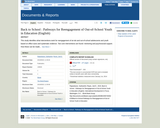
World Bank report which explores the reasons for Out-of-School youth and what needs to be done to get them back into schooling.

This resource is a video abstract of a research paper created by Research Square on behalf of its authors. It provides a synopsis that's easy to understand, and can be used to introduce the topics it covers to students, researchers, and the general public. The video's transcript is also provided in full, with a portion provided below for preview:
"Colorectal cancer is the fourth most common cancer and the fifth leading cause of cancer death worldwide. Two important hallmarks of the disease are faulty tumor suppressor genes and altered composition of the community of microbes that live in the colon. That prompted researchers to explore whether there is a connection between the two. They examined 33 tissue samples from patients with colorectal cancer. Protein-assisted DNA sequencing revealed the prominence of Fusobacterium nucleatum, pathogenic bacteria associated with gum disease, and Hungatella hathewayi, rod-shaped bacteria with no substantial track record of causing disease. Further experiments showed that these bacteria can actually mute genes that normally suppress cancer, promoting the spread of colorectal cancer cells. The findings are unexpected evidence that bacteria in the colon can regulate genes linked to cancer suppression and reveal at least a few targets for anti-cancer therapy..."
The rest of the transcript, along with a link to the research itself, is available on the resource itself.

This resource is a video abstract of a research paper created by Research Square on behalf of its authors. It provides a synopsis that's easy to understand, and can be used to introduce the topics it covers to students, researchers, and the general public. The video's transcript is also provided in full, with a portion provided below for preview:
"The birth of a child involves many big transitions, but one of these changes occurs inside the child, who transitions from the sterile womb to an outside environment full of microbes. While this has lasting effects on growth, inflammation, and immunity, remarkably little is known about how gut bacteria and viruses are acquired by infants. Recently, researchers used next-generation sequencing to evaluate microbes from the guts of 28 pairs of twins and their mothers. They found that the majority of the infant’s gut bacteria were similar to their mother’s gut bacteria. Viruses were less similar, suggesting they might be transmitted through other routes. Twins also shared more of their gut microbiota with each other, emphasizing the strong effect of environmental exposure, and mode of delivery had very little effect on how much of the infants’ gut microbiome was inherited from their mothers..."
The rest of the transcript, along with a link to the research itself, is available on the resource itself.

This resource is a video abstract of a research paper created by Research Square on behalf of its authors. It provides a synopsis that's easy to understand, and can be used to introduce the topics it covers to students, researchers, and the general public. The video's transcript is also provided in full, with a portion provided below for preview:
"Crohn’s disease is an incredibly painful inflammatory bowel disease that frequently reoccurs after treatment. The growth of a certain type of abdominal fat has been associated with Crohn's disease recurrence. This fat, called mesenteric adipose tissue, is tucked up against the membrane connecting the intestines to the abdominal wall. Microbes can escape the intestines in Crohn's disease and may affect the mesenteric fat. Recently, researchers explored this relationship by investigating the mesenteric microbiome of patients with Crohn’s disease. Crohn’s disease patients had distinct mesenteric microbiomes, host gene expression patterns, and metabolites compared to controls. To explore the specifics, the researchers isolated bacterial strains from the mesenteric microbiome of these patients. In a mouse model of colitis, introducing a mixture of five of the isolated bacterial strains made disease symptoms worse. One of these strains, _A..."
The rest of the transcript, along with a link to the research itself, is available on the resource itself.

This resource is a video abstract of a research paper created by Research Square on behalf of its authors. It provides a synopsis that's easy to understand, and can be used to introduce the topics it covers to students, researchers, and the general public. The video's transcript is also provided in full, with a portion provided below for preview:
"Our microbiomes are in continuous exchange with the microorganisms living in our indoor environments. In hospitals, this interaction may play a critical role in hospital-acquired infections and the rise of antibiotic-resistant bacteria. However, the bacterial colonization dynamics in newly opened hospitals are poorly understood. In a recent study, researchers used a longitudinal metagenomic approach to characterize this process in a newly occupied hospital ward. Sequencing data showed that the taxonomic succession was site-specific and led to stable community structures after only a few weeks. This fast colonization process was characterized by a significant increase in the bacterial biomass and its alpha-diversity. The bacterial composition of the environment could also be linked to exchanges with patient microbiota. They did not detect a rise in pathogenic bacteria during the 30-week study, but the number of antibiotic resistance genes found on the hospital floor increased over time..."
The rest of the transcript, along with a link to the research itself, is available on the resource itself.

This resource is a video abstract of a research paper created by Research Square on behalf of its authors. It provides a synopsis that's easy to understand, and can be used to introduce the topics it covers to students, researchers, and the general public. The video's transcript is also provided in full, with a portion provided below for preview:
"Microbes are all around us. With around the same number of bacteria as cells in each human body, our microbiomes are constantly interacting with microbes in the surrounding environment. And indoor environmental microbes can influence our health, affecting allergies, asthma, and other health conditions. To better characterize indoor microbial communities, researchers conducted an environmental assessment as part of an epidemiologic study of 50 elementary schools in a large city in the United States. They identified more than 2,000 bacterial species in floor dust collected from 500 classrooms. The most abundant bacterial phyla were Firmicutes and Proteobacteria, and interestingly, the genus Halospirulina was reported for the first time in a classroom sample. Outdoor-associated and gram-negative bacteria were more abundant in classroom floor dust compared to homes, where human-associated and gram-positive bacteria are more abundant..."
The rest of the transcript, along with a link to the research itself, is available on the resource itself.

This resource is a video abstract of a research paper created by Research Square on behalf of its authors. It provides a synopsis that's easy to understand, and can be used to introduce the topics it covers to students, researchers, and the general public. The video's transcript is also provided in full, with a portion provided below for preview:
"Infectious microbes don’t stop at the hospital door upon admission. Hospital surfaces serve as a reservoir of microbial life that may colonize patients, resulting in healthcare-associated infections (HAIs). The most vulnerable are critically ill patients in the intensive care unit (ICU), where HAIs represent the leading cause of death. Unfortunately, little is known about how the microbiome of the ICU is established or how it is influenced over time. A new study took advantage of a unique opportunity to examine the evolution of the ICU microbiome. Researchers examined microbes isolated from ICU surfaces before, during, and after hospital renovations closed the unit. Using DNA sequencing, they found that the greatest bacterial diversity existed before ICU closure..."
The rest of the transcript, along with a link to the research itself, is available on the resource itself.

This resource is a video abstract of a research paper created by Research Square on behalf of its authors. It provides a synopsis that's easy to understand, and can be used to introduce the topics it covers to students, researchers, and the general public. The video's transcript is also provided in full, with a portion provided below for preview:
"In ecology research, population density is an important metric for community analysis studies. Yet even though microbiomes are small ecosystems, microbiome studies rarely report the bacterial density. To evaluate the significance of bacterial density in gut microbiome research, a recent retrospective study examined rectal swabs from hospitalized patients. The authors found that bacterial density had important methodologic significance, as it predicted vulnerability to sequencing contamination. Specifically, low-bacterial-density specimens had higher levels of sequencing contamination. Clinical factors like age, exposure to antibiotics, and comorbidities also varied with bacterial density. Older patients and those with multiple co-morbidities had high bacterial density, while antibiotic exposure correlated with low density. Lastly, bacterial density showed potential as a prognostic indicator, as the density at time of admission correlated with subsequent infection..."
The rest of the transcript, along with a link to the research itself, is available on the resource itself.

This resource is a video abstract of a research paper created by Research Square on behalf of its authors. It provides a synopsis that's easy to understand, and can be used to introduce the topics it covers to students, researchers, and the general public. The video's transcript is also provided in full, with a portion provided below for preview:
"Trees support so much life on Earth – but one important component might easily be overlooked. The phyllosphere – the aerial surfaces of plants, including leaves – is a microbial habitat for diverse microorganisms. Phyllosphere bacteria play key roles in plant health, human health, and ecosystem function, but unfortunately, not much is known about how plants and their associated microbes influence each other. A recent study evaluated this relationship in a diverse neotropical forest. Using shotgun metagenomics, researchers found that the metabolic functions of phyllosphere microbes varied based on their tree hosts. While overall there was low variability in plant-associated microbes, suggesting that certain microbes form a “core microbiota” for neotropical trees, bacterial metabolism and membrane transport functions varied between plant species..."
The rest of the transcript, along with a link to the research itself, is available on the resource itself.
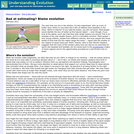
The next time you are in the kitchen, try this experiment: pick up a box of butter (four sticks) in one hand and a box of saltines (four packets) in the other. Which is heavier? If you said the butter, you are not alone. Most people would identify the box of butter as the heavier object even though, if you look at the labels, you'll see that they both weigh exactly one pound! This is an example of the size-weight illusion, and it is incredibly common. Read more to see the evolution (and baseball) connection ...

The Center for Food Safety and Applied Nutrition (CFSAN) prepared this online handbook on foodborne pathogenic microorganisms (bacteria, viruses and parasites) and natural toxins. Chapters are arranged under the following headings: Pathogenic Bacteria, Enterovirulent Escherichia Coli Group, Parasitic Protozoa and Worms, Viruses, Natural Toxins, Other Pathogenic Agents, and Appendices. The intent of each chapter is to provide basic facts regarding these organisms and toxins including their characteristics, habitat or source, associated foods, infective dose, characteristic disease symptoms, complications, recent and/or major outbreaks, and any susceptible populations. The chapters also contain minimal information on the analytical methods used to detect, isolate, and/or identify the pathogens or natural toxins.
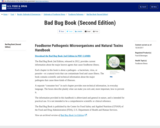
A book on foodborne pathogens and natural toxins

This zine is a collection of biographies and portraits of badass womxn in the Pacific Northwest. Undergraduate students collaborated to create this resource that fuses multilingual poetry, art, and writing to celebrate and honor some of the strongest people you might not have heard of.

Background: The reproducibility policy at the journal Biostatistics rewards articles with badges for data and code sharing. This study investigates the effect of badges at increasing reproducible research. Methods: The setting of this observational study is the Biostatistics and Statistics in Medicine (control journal) online research archives. The data consisted of 240 randomly sampled articles from 2006 to 2013 (30 articles per year) per journal. Data analyses included: plotting probability of data and code sharing by article submission date, and Bayesian logistic regression modelling. Results: The probability of data sharing was higher at Biostatistics than the control journal but the probability of code sharing was comparable for both journals. The probability of data sharing increased by 3.9 times (95% credible interval: 1.5 to 8.44 times, p-value probability that sharing increased: 0.998) after badges were introduced at Biostatistics. On an absolute scale, this difference was only a 7.6% increase in data sharing (95% CI: 2 to 15%, p-value: 0.998). Badges did not have an impact on code sharing at the journal (mean increase: 1 time, 95% credible interval: 0.03 to 3.58 times, p-value probability that sharing increased: 0.378). 64% of articles at Biostatistics that provide data/code had broken links, and at Statistics in Medicine, 40%; assuming these links worked only slightly changed the effect of badges on data (mean increase: 6.7%, 95% CI: 0.0% to 17.0%, p-value: 0.974) and on code (mean increase: -2%, 95% CI: -10.0 to 7.0%, p-value: 0.286). Conclusions: The effect of badges at Biostatistics was a 7.6% increase in the data sharing rate, 5 times less than the effect of badges at Psychological Science. Though badges at Biostatistics did not impact code sharing, and had a moderate effect on data sharing, badges are an interesting step that journals are taking to incentivise and promote reproducible research.

Beginning January 2014, Psychological Science gave authors the opportunity to signal open data and materials if they qualified for badges that accompanied published articles. Before badges, less than 3% of Psychological Science articles reported open data. After badges, 23% reported open data, with an accelerating trend; 39% reported open data in the first half of 2015, an increase of more than an order of magnitude from baseline. There was no change over time in the low rates of data sharing among comparison journals. Moreover, reporting openness does not guarantee openness. When badges were earned, reportedly available data were more likely to be actually available, correct, usable, and complete than when badges were not earned. Open materials also increased to a weaker degree, and there was more variability among comparison journals. Badges are simple, effective signals to promote open practices and improve preservation of data and materials by using independent repositories.
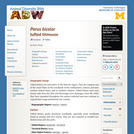
Baeolophus bicolor: Information

This resource is a video abstract of a research paper created by Research Square on behalf of its authors. It provides a synopsis that's easy to understand, and can be used to introduce the topics it covers to students, researchers, and the general public. The video's transcript is also provided in full, with a portion provided below for preview:
"Alzheimer’s disease (AD) is the leading cause of dementia in the aged population. The key feature of AD is the deposition of two different kinds of protein aggregates in the brain, and at the point of aggregate formation, treatment becomes difficult. A recent study focused on how to prevent the aggregation of one protein: the microtubule-associated protein Tau, which forms neurofibrillary tangles. Following up on research indicating that polyphenolic compounds can serve as neuroprotective agents, researchers analyzed the ability of the polyphenol Baicalein to inhibit the aggregation of Tau. In vitro, Baicalein blocked Tau aggregation and paired helical filament dissolution via an oligomer capture and dissociation mechanism. It also dissolved preformed mature fibrils of Tau, creating Tau oligomers, with no effect on the viability of neuronal cells..."
The rest of the transcript, along with a link to the research itself, is available on the resource itself.